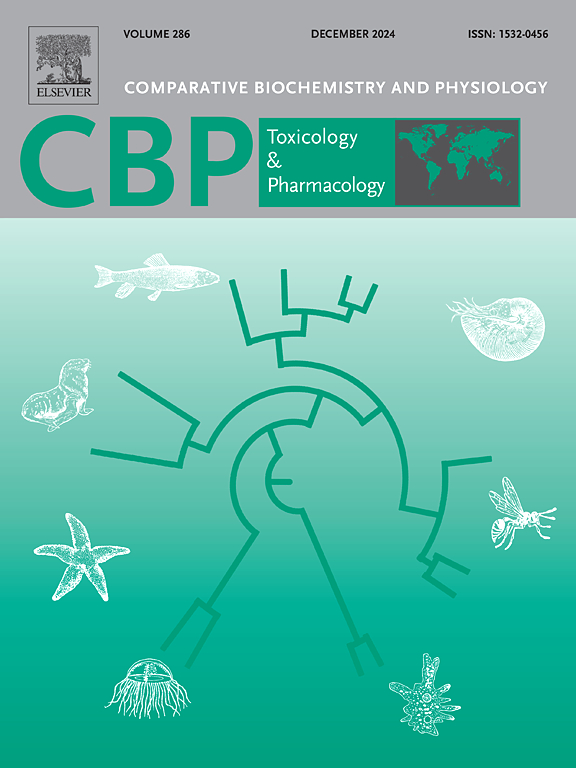NADPH氧化酶在泥蟹(Scylla paramamosain)对副溶血性弧菌感染反应中的作用。
IF 4.3
3区 环境科学与生态学
Q2 BIOCHEMISTRY & MOLECULAR BIOLOGY
Comparative Biochemistry and Physiology C-toxicology & Pharmacology
Pub Date : 2025-02-22
DOI:10.1016/j.cbpc.2025.110158
引用次数: 0
摘要
活性氧(ROS)对维持细胞稳态和功能至关重要。细胞内ROS的主要来源是NADPH氧化酶(Nox),在动物免疫耳聋中起着至关重要的作用。然而,氮氧化物在甲壳类动物中的作用尚不清楚。本研究从泥蟹中克隆并鉴定了一个Nox基因(命名为Sp-Nox)。Sp-Nox全长包含3939 bp的开放阅读框,编码1312个氨基酸,5' untranslation region (UTR) 420 bp, 3' untranslation region (UTR) 813 bp。Sp-Nox的氨基酸序列包含一个典型的黄素腺嘌呤二核苷酸(FAD)结合域和一个烟酰胺腺嘌呤二核苷酸(NAD)结合域。Sp-Nox在所有组织中广泛表达,在鳃中表达量最高。副溶血性弧菌感染后肝胰腺中Sp-Nox的表达显著上调。为了进一步了解Sp-Nox的调控机制,我们进行了RNA干扰实验。体内敲低Sp-Nox可显著降低ROS的产生和抗氧化相关基因(CAT和SOD)的表达水平。Sp-Nox干扰显著提高了副溶血性弧菌感染后泥蟹的死亡率。上述结果表明,Sp-Nox在甲壳类动物对副溶血性弧菌感染的防御中发挥了重要作用。本文章由计算机程序翻译,如有差异,请以英文原文为准。

The role of NADPH oxidase in the mud crab (Scylla paramamosain) in response to Vibrio parahaemolyticus infection
Reactive oxygen species (ROS) are critical for maintaining cellular homeostasis and function. The main source of intracellular ROS depends on the NADPH oxidase (Nox) and plays crucial roles in immune deafens in animal. However, the function of Nox in crustaceans remains unclear. In the present study, a Nox gene from the mud crab (designated as Sp-Nox) was cloned and identified. The full length of Sp-Nox contained an open reading frame of 3939 bp encoding 1312 amino acids, a 5′ untranslated region (UTR) of 420 bp, and a 3′ UTR of 813 bp. The deduced amino acid sequences of Sp-Nox contained a typical flavin adenine dinucleotide (FAD) binding domain and a nicotinamide adenine dinucleotide (NAD) binding domain. Sp-Nox was widely expressed in all tested tissues, with the highest expression levels in the gill. Sp-Nox expression in hepatopancreas was significantly up-regulated after V. parahaemolyticus infection. In order to know more about the regulation mechanism of Sp-Nox, RNA interference experiment was investigated. Knocking down Sp-Nox in vivo can significantly reduce the production of ROS and the expression levels of antioxidant-related genes (CAT and SOD). Moreover, Sp-Nox interference significantly increased the mortality of mud crabs after V. parahaemolyticus infection. All these results suggested that Sp-Nox played a crucial role in the defense against V. parahaemolyticus infection in crustaceans.
求助全文
通过发布文献求助,成功后即可免费获取论文全文。
去求助
来源期刊
CiteScore
7.50
自引率
5.10%
发文量
206
审稿时长
30 days
期刊介绍:
Part C: Toxicology and Pharmacology. This journal is concerned with chemical and drug action at different levels of organization, biotransformation of xenobiotics, mechanisms of toxicity, including reactive oxygen species and carcinogenesis, endocrine disruptors, natural products chemistry, and signal transduction with a molecular approach to these fields.

 求助内容:
求助内容: 应助结果提醒方式:
应助结果提醒方式:


